Ritterkreuz des Eisernen Kreuzes
Militaria Preisdatenbank
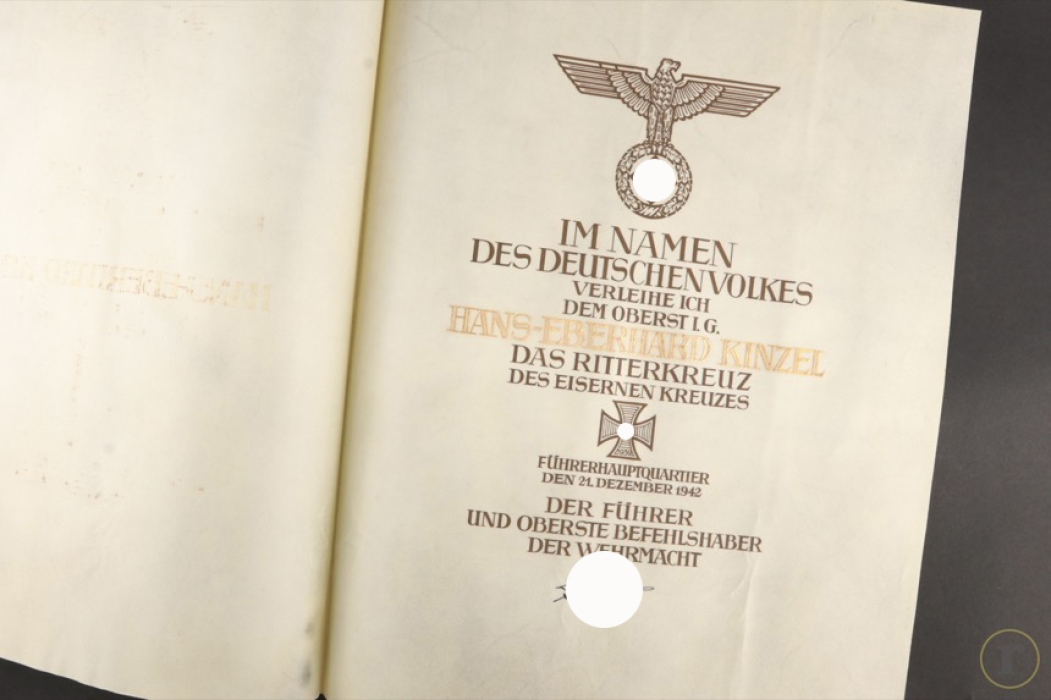
Oberst i.G. Hans-Eberhard Kinzel - Urkunde zum Ritterkreuz des Eisernen Kreuzes
MILITARIA PREISDATENBANK
Wie kann ich Verkaufspreise sehen?
Melden Sie sich noch heute unter www.ratisbons.com/de/militaria-preisdatenbank für unsere MILITARIA PREISDATENBANK an! Bei Abschluss eines jährlichen Abonnements für nur 75€ sparen Sie 25%.
Ihr Zugang zu allen Verkaufspreisen, Bildern und Beschreibungen wird umgehend nach Abschluss Ihres Abonnements freigeschaltet.
Wir kaufen Einzelstücke und ganze Sammlungen und beraten Sie auch gerne telefonisch: 08541 9053699
-
Bezahlung
-
WIE KANN ICH FÜR MEINE BESTELLUNG BEZAHLEN?
AUKTIONAlle erfolgreichen Gebote werden automatisch zu einer einzigen Bestellung zusammengefasst. Für diese können Sie uns nach Auktionsende in Ihrem persönlichen Kundenkonto Ihre bevorzugte Bezahl- und Versandart oder eine alternative Lieferadresse mitteilen.
Wenn wir diese freiwilligen Angaben nicht von Ihnen erhalten melden wir uns automatisch im Laufe des Montags nach Auktionsende mit einer Zahlungsanweisung per Email. Basierend auf Erfahrungswerten schlagen wir Ihnen die bequemste Bezahlmehtode und die günstigste Versandart vor. Sie möchten Ihre Bezahl- und Versandart ändern oder eine alternative Lieferadresse angeben? Kein Problem! Besuchen Sie Kundenkonto/BESTELLUNGEN oder kontaktieren Sie uns per Email.
BESTELLUNGEN IM ONLINESHOPWählen Sie während der Bestellung Ihre bevorzugte Bezahl- und Versandart und schicken Sie diese ab. Sie erhalten Ihre Zahlungsanweisung spätestens am darauffolgenden Tag per Email. Die Zahlungsfrist beträgt sieben Tage. Sie planen eine Bestellung per Ratenzahlung zu begleichen? Bitte sprechen Sie uns gerne vor Ihrer Bestellung darauf an.
Für mehr Informationen zu Bezahlung und Versand, besuchen Sie unsere Häufigen Fragen.
WIR AKZEPTIEREN FOLGENDE BEZAHLARTEN
-
-
Versand
-
IHRE BESTELLUNG IN DEN BESTEN HÄNDEN
VERPACKUNG & SENDUNGSVERFOLGUNGNach Zahlungseingang versenden wir Ihre Bestellung für gewöhnlich am darauffolgenden Werktag. Wir bestätigen den Eingang Ihrer Zahlung per Email und informieren Sie zur Versandvorbereitung. Nach Abholung der Sendung durch unsere Versanddienstleister teilen wir Ihnen die Sendungsnummer per Email mit. Den Status Ihrer Sendung können Sie auch jederzeit unter Kundenkonto/BESTELLUNGEN einsehen. Ihre Rechnung geht Ihnen automatisch am Tag des Versands zu.
VERSAND ZU EINER ALTERNATIVEN ADRESSEBevorzugen Sie für eine Bestellung einen Versand zu Ihrer Arbeitsstelle? Sie sind im Urlaub und wünschen den Versand zu einer Packstation oder einem Freund? Kein Problem! Diese Änderungen können Sie jederzeit unter Kundenkonto/BESTELLUNGEN vornehmen. Alternativ können Sie natürlich jederzeit auch per Email informieren.
UNSERE PARTNER FÜR DEN VERSAND
-
-
Garantie
-
 GARANTIE!
GARANTIE!Alle angebotenen Artikel werden von unseren Experten akribisch auf deren Echtheit geprüft und detailiert beschrieben. Wir bieten ausschließen zeitgenössiche Originale an. Etwa 15% aller Kundeneinlieferungen ensprechen unseren Anforderungen nicht und werden retourniert.
Gekauft wie gesehen? Nicht bei uns. Im Gegensatz zu traditionellen Auktionshäusern bieten wir volles Rückgaberecht of Originalität an. Sollten Sie mit Ihrer Bestellung nicht zufrieden sein, können Sie die Bestellung innerhalb 14 Tagen widerrufen. Bitte kontaktieren Sie uns vor dem Rückversand. Für mehr Einzelheiten besuchen Sie bitte unsere häufigen Fragen.
In eigener Sache: Bieten Sie nur auf Lose, die Sie auch erwerben möchten. Bitte vermeiden Sie Gebote nach Auktionende zu stornieren. Sollten Sie ein fehlerhaftes Gebot abgegeben haben, informieren Sie uns bitte umgehend. Wir löschen Ihre Gebote gerne bis 24 Stunden vor Ende der Auktion.
-
Land Deutsches Reich 1918 - 1945
Maße 43.8 x 35.5 cm
Gewicht
 US Los 62-0005
US Los 62-0005EAN 3000000016084
 US Los 62-0005
US Los 62-0005Epoche 1918 — 1945
Land Deutsches Reich 1918 - 1945
Land Deutsches Reich 1918 - 1945
 US Los 62-0005
US Los 62-0005Deutsches Reich 1918 - 1945
Ritterkreuz des Eisernen Kreuzes
Beschreibung
Obert i.G. Eberhard Kinzel (October 18, 1897 – June 25, 1945)
Obert i.G. Eberhard Kinzel joined the Imperial Army on October 16, 1914, as a war volunteer. He was assigned to the 3rd Brandenburg Infantry Regiment "Graf Tauentzien von Wittenburg" No. 20. At the beginning of 1915, he also embarked on an officer's career with this regiment. In May 1915 he was wounded as an ensign at the front. In mid-July 1915, after recovering, he returned to the troops. On July 30, 1915, he was promoted to lieutenant. His rank seniority was later set at November 1, 1915. During the course of the First World War he was employed in various functions in his 3rd Brandenburg Infantry Regiment "Graf Tauentzien von Wittenburg" No. 20. In World War I he was awarded the Knight's Cross of the Royal Prussian House Order of Hohenzollern with swords and both Iron Crosses as well as other awards. After the war, after a certain period of time, he was taken on by the Freikorps von Oven in the Imperial Army. In the spring of 1920, he was then deployed in the interim army with the 6th Reichswehr Infantry Regiment. When the 100,000-man army of the Reichswehr was formed, he then became an orderly officer 5th (Prussian) Infantry Regiment. In 1921 he was assigned to this regiment as a company officer of the 14th company. From April 1, 1923, he was employed as adjutant of the training battalion of the 5th (Prussian) Infantry Regiment in Greifswald. As such, he was promoted to Oberleutnant in the summer of 1925. The rank seniority was set to April 1, 1925. On October 1, 1926, he was then assigned to the staff of the 2nd Division of the Reichswehr for the next two years for leadership assistant training transferred to Szczecin. After that, he continued to be assigned to this staff, but on October 1, 1928, he was assigned to the Berlin Command. On October 1, 1929, he was then assigned to the Reichswehr Ministry in Berlin. On October 1, 1930, he was also officially transferred to the Reichswehr Ministry. There he was then deployed in the Foreign Armies Department (T 3) of the Troops Office (TA). There he was promoted to captain on February 1, 1932. On October 1, 1933, he was transferred to the German Embassy in Warsaw. There he was now employed as an assistant to the military attaché. There he was promoted to Major in January 1936. The rank seniority was set to January 1, 1936. On April 1, 1936, he was transferred to the 66th Infantry Regiment. On April 1, 1937, he became the 1st General Staff Officer of the 19th Infantry Division in Hanover. On November 10, 1938, he was transferred to the Army High Command in Berlin. There he was now charged with maintaining the business of the department head of the 12th department (12th Dept.) at the Oberquartiermeister IV (O Qu IV). On February 1, 1939, he was promoted to lieutenant colonel iG. The rank seniority was dated March 1, 1938. As such, he has now been appointed Head of the Department of Foreign Armies East II. He remained in this position for the next few years. He was promoted to Colonel iG on February 1, 1941. In this function he was also awarded both clasps for his Iron Crosses. In March 1941 he appeared in Budapest in March 1941 with a letter from Generaloberst Halderto the Hungarian Colonel-General Werth. This letter contained the German wish for Hungary to participate in a possible Yugoslav war with the five mobilized Hungarian army corps against the Soviet Union. The letter held out the prospect of the imminent arrival of a German delegation headed by Generalleutnant Paulus in Budapest to discuss operational cooperation and the German advance against southern Slavia via Hungarian territory. Kinzel then took the answer back to Berlin. On May 1, 1942, he was replaced by Lieutenant Colonel Reinhard Gehlen in the OKH and transferred to the Führerreserve. On May 23, 1942, he was appointed Chief of the General Staff of the XXIX. Army Corps. On November 12, 1942, he was again transferred to the Führerreserve. During this phase he headed the German liaison staff at the Italian II Army Corps from December 15 to 22, 1942. On December 23, 1942, he was awarded the Knight's Cross of the Iron Cross for his work as chief of the Foreign Armies East Department. On January 1, 1943, he was promoted to major general. As such, he was now appointed Chief of the General Staff by the General Command zbV Cramer. On January 22, 1943, he was appointed Chief of Staff of Army Group North. On September 1, 1943, he was promoted to Generalleutnant. In mid-July 1944 he was relieved and transferred to the Führerreserve. On September 1, 1944, he was appointed commander of the 570th Volks-Grenadier-Division. By renaming the unit, he was then appointed commander of the 337th Volks-Grenadier-Division on September 15, 1944. At the beginning of March 1945, he relinquished his command. He was appointed Chief of Staff of Army Group Vistula that month. On April 20, 1945, he was promoted to General der Infanterie. As such, on April 22, 1945, he became Chief of the General Staff of Operations Staff North under Grand Admiral Dönitz. At the beginning of May 1945, he was part of the delegation at the capitulation negotiations at Field Marshal Montgomery's headquarters together with General Admiral Hans-Georg von Friedeburg, Rear Admiral Gerhard Wagner, Major Jochen Friedel and Colonel iG Fritz Poleck. With the capitulation he was taken prisoner. There he committed suicide in May 1945. (From Lexikon der Wehrmacht)
Knights Cross of the Iron Cross formal award document issued to Obert i.G. Hans-Eberhard Kinzel on parchment with an integral blank front leaf, Führerhauptquartier, December 21, 1942. The ornately lettered document is executed in India ink and gold with a hand-inked signature of Adolf Hitler at the bottom. The parchment is just the slightest bit wavy, as is very common in such documents, but otherwise fine condition. Award documents for the Knight’s Cross are rare, even though Hitler granted over 7,000 of them. A severe backlog soon developed and, in the end, very few recipients of the award ever received their large formal award documents.
The document is part of a veteran bring-back that we proudly offer here for the very first time. The GI opted to bring 9 single formal documents in one red presentation leather folder (Mappe) which will be auctioned with Ratisbon’s through a couple of auctions.
Zustand
1-
Verkäufer
History Trader Inc., 521 Thorn Street #165, Sewickly, PA 15143-0165, USA
NAME
Ritterkreuz des Eisernen Kreuzes
DATUM DER STIFTUNG
1. September 1939 als dritte und neue Stufe des wiederhergestellten Ordens vom Eisernen Kreuz
AUSZEICHNUNGSKRITERIEN
Das Ritterkreuz des Eisernen Kreuzes wurde für besondere Tapferkeit im Angesicht des Feindes und für heraus- ragende Verdienste um die Truppenführung verliehen. Die Verleihung des Ritterkreuzes erforderte die vorherige Vergabe der beiden niedrigeren Stufen. Das Ritterkreuz wurde allein vom Führer auf Vorschlag der Einheit des Soldaten verliehen und vom Heerespersonalamt ausgestellt. Die Ritterkreuze wurden in der Ordenskanzlei in Berlin aufbewahrt, um nach Genehmigung dem Beliehenen zugeschickt zu werden. Vor Ende April 1945 wurden auf keiner Ebene der Wehrmacht Ritterkreuze gelagert.
HERSTELLER
Das Ritterkreuz des Eisernen Kreuzes wurde von sieben Herstellern gefertigt, Varianten innerhalb den einzel- nen Firmen nicht berücksichtigt. Die Ritterkreuze findet man entweder ungestempelt (frühe Juncker und 3/4 Ring Kreuz), mit Silbergehaltsstempel, mit einer LDO-Nummer (L/12 und L/52) und später mit der Präsidialkanzlei- Nummer des Herstellers (2, 20, 65 und 4). Privatverkauf war ab Oktober 1941 verboten.
VERLEIHUNGSZAHLEN
Genaue Zahlen sind nicht bekannt, aber die Schätzungen liegen bei 7.200 und ein paar hundert mehr auf Laager bei der Präsidialkaanzlei.
AUSZEICHNUNGSUNTERLAGEN
Der Beliehene erhielt eine vorläufige Urkunde im Format A5, ausgestellt im Namen des Führers von den zustän- digen Personalämtern der drei Wehrmachtsteile. Die formellen Urkunden (Große Mappe) wurden später aus- gestellt und sind aufgrund des großen Herstellungsrückstandes nur mit Datum Ende 1942/Anfang 1943 zu finden.
TRAGEMETHODE
Das Ritterkreuz wurde mit dem rot/weiß/schwarzen Band als Halsorden getragen. Das Ritterkrreuz wurde im schwarzem Etui und beiliegendem Band verliehen.



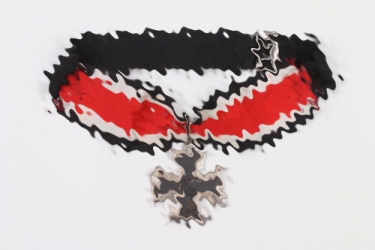



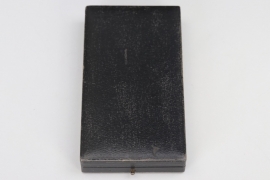

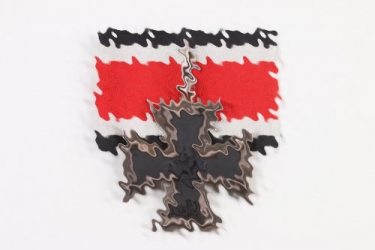



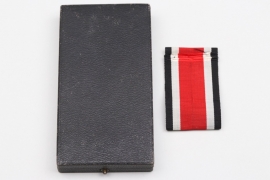




.jpg)
.jpg)






